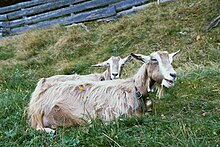Toggenburg goat
The Toggenburg goat is a light brown and white colored goat breed whose main breeding area is in Obertoggenburg in the canton of St. Gallen . It is considered an extremely robust goat and has therefore been exported to many countries, where it was purely further bred or crossed into local goat breeds.
Traditional attitude and meaning
The Toggenburg goat was created around 1850, in the course of the breed definitions during this period, today's main goat breeds in Switzerland were defined. Interested breeders very soon founded so-called breeding cooperatives with the aim of promoting goat breeds. In the canton of St.Gallen, several such breeding cooperatives were set up very early (from 1892), which aimed to breed the Toggenburg goats.
In addition to the color, special attention was paid to the body structure. (Well-placed, strong limbs, high weight, good udder with a pronounced fore udder and correct teat set.)
Traditionally, the Toggenburg goat is kept in small numbers by farmers. They like to keep them together with other animals (mostly cows ) on the pasture. Since goats eat a lot of herbs and bushes that are spurned by cows, this has advantages in terms of pasture maintenance , but means more work when fencing the pasture areas, since goats, unlike cows, cannot be prevented from breaking out by a simple electric fence.
Small numbers of Toggenburgers are also happy to be summered on cowsheds, where they do a lot to look after the landscape.
Physical characteristics
The Toggenburg goat is a strongly built, medium-sized goat with a rather elongated build (height at the withers of the females 70–80 cm, the males 75–85 cm; minimum weight females 45 kg, males 65 kg).
The animals are mostly hornless, but horned ones are also allowed for breeding. The horns are occasionally asymmetrical or fused.
All specimens have strong beards, most of them have shaggies. The coat is smooth and short to medium in length. The hair on the chest and especially on the flanks is typically longer and lighter in color than on the rest of the body (coat).
The striking basic color, which is described as light brown to mouse gray, is characteristic. All Toggenburgers have white markings on the mirror, limbs, ears and head. The markings on the head run, just like on the Bündner radiant goat , as stripes from the mouth to the base of the horn.
The udder is well attached and compact.
The Toggenburg goat is considered to be the goat with the best feet and legs (ie the healthiest physique), which explains its great popularity as a breeding goat outside of its home region.
Essence
Toggenburg goats are lively and very curious pets. Her great confidence is remarkable. The goat is also not shy of other animals (e.g. dogs or large livestock), possibly a result of traditional husbandry with other farm animals.
Toggenburgers do not have a particularly strong herd instinct and prefer to separate themselves from the herd in small groups. It seems to feel most comfortable in small herds of three to eight animals. Their urge to move is limited, so Toggenburgers are better suited for (running) stable housing than the Swiss mountain goat breeds bred for marching ability.
Thanks to their character, their unpretentiousness and their trustworthiness, Toggenburg goats are also popular with hobby goat keepers who derive little or no material benefit from their keeping.
power
On average, Toggenburg goats in Switzerland give 809.6 kg of milk per lactation , with 270.3 milking days (this corresponds to 3 kg per day). With appropriate housing and feeding, significantly higher yields are possible. The mean content of fat (3.1%) and protein (2.8%) is comparatively low.
Duration
The population of Toggenburgers in Switzerland has been increasing slightly for years and is currently (as of May 13, 2013) at 3873 animals in the herdbook. This makes it the third most common goat breed in Switzerland and is not considered endangered.
The Toggenburger is also a breeding goat recognized in the USA, Canada, Germany, Austria and the Netherlands. It has also been crossed with some foreign goat breeds, such as the British Toggenburger in England, the Thuringian forest goat from Germany or the Dutch pinto from the Netherlands.
literature
Urs Weis (ed.): Swiss goats. Birken Halde Verlag, 2004.


